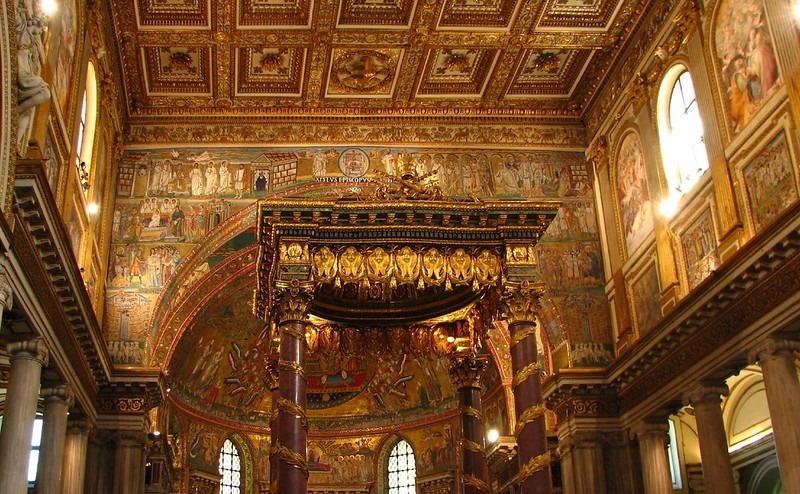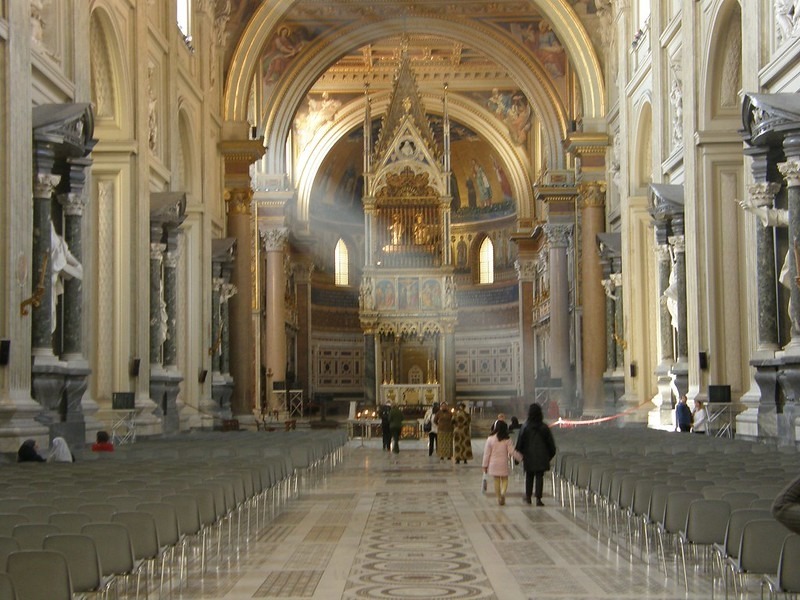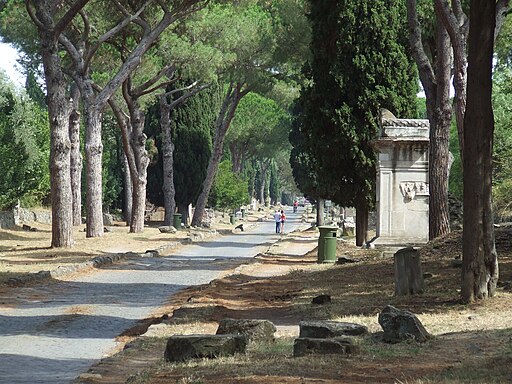“Upon this rock I will build my Church.” Matthew 16:18
Where should Catholics visit in Rome? As bucket-list destinations go, this ancient and magnificent city is in many people’s top ten, but for Catholic pilgrims its not about la cucina italiana and the Colosseum at dusk. The centre of the known world at the time of the early Church, Christians were persecuted here for their faith until the legalisation of Christianity in 313. 13 years later St Helena, mother of emperor Constantine, organised the safe transit of the most sacred relics of the faith from Jerusalem to the heart of the empire – Rome.
Long before that however, Rome was the place where many of the earliest martyrs were born, lived and died, and as the seat of the Pope, it is one of the two great holy cities of the world alongside Jerusalem.
For Catholics, a pilgrimage to Rome is a spiritual odyssey. Many will come with plans to see St Peter’s and the other Major Basilicas, many will come to walk in the footsteps of Saints Peter and Paul, the Pillars of the Church. Some may even seek to attend mass and catch a glimpse of the Pope himself, but none are prepared for the impact that this mind-blowing city has on their lives.
So where exactly should Catholics visit in Rome? We’ve curated the following list, in no particular order, of places that will stir the faith of those who have it buried deep in their heart and will inspire those who already feel close to the Lord.
1) Where Should Catholics Visit in Rome? St Peter’s Basilica!

Well duh! St Peter’s is of course the most famous church in the world and the very first thing that anyone must see—Christian or otherwise—when visiting Rome. For mainstream culture-junkies however, the real attraction is the Vatican Museums, said to be the largest and most priceless collection in the world and for those same people we’d recommend the view of St Peter’s from the outside. Its unmistakable facade makes it one of the most majestic buildings in the world and just being in its shadow is enough to fill anyone with awe.
However the real treasures of St Peter’s are inside the basilica, for which there is no skipping the line. You’ll be up with the larks or queuing for several hours, possibly longer during the Jubilee, for St Peter’s is of course the site of one of the four Holy Doors that will open throughout the year for pilgrims to pass through.
For more information about the indulgences granted to those of the faith and the conditions associated, check out this article.
Inside, you’ll marvel at the interior of one of the holiest places on Earth, see the Catechesis in the mosaics and even catch a glimpse of the entrance to his tomb. To visit this most iconic of Catholic churches, join us on our St Peter’s Basilica Tour, or see all of the Holy Doors on our Holy Doors Tour. To simply learn more about Sts Peter & Paul, you should also join the St Peter & St Paul Tour!
2) Where Should Catholics Visit in Rome? St Paul’s Basilica!

St Paul’s Outside the Walls is another of the four Major Basilicas in Rome and site of another of the Holy Doors. Due to its location just outside of the ancient Aurelian Walls, which unofficially denote the historical city centre of Rome, St Paul’s is some what of a poor relation to the other three when it comes to tourism.
However, the final resting place of St Paul the Apostle is naturally a beacon to those of the faith and this grand and beautiful basilica is still not only an absolute must for pilgrims seeking indulgence during the Holy Year but also a hidden gem to those just in it for the art.
Just a very short trip out of the centre by metro brings you to the neighbourhood of the same name (San Paolo), where you’ll see far fewer tourists and catch a glimpse of real Rome suburban life. Check out our St Paul’s Basilica Tour or our St Peter & St Paul Tour to learn more about this great Apostle of the Gentiles and visit his tomb.
3) Where Should Catholics Visit in Rome? The Basilica of St Mary Major!

The third Major Basilica in our list and, of course, the location of another of the Holy Doors, St Mary Major – a magnificent and ancient church located deep in the heart of town near the trendy Monti district and Termini Station.
Home to the relics of Pope St Pius V, a famous icon painted by St Luke the Evangelist, and most importantly relics of the birth of Jesus, Santa Maria Maggiore (St Mary Major) is also closely linked to Christmas and is therefore the focal point of any Catholic Christmas tour experience.
To visit the magnificent Basilica, simply join our St Mary Major Tour, or our Holy Doors Tour, or for the most bang for your buck, our best selling tour – the Via Crucis Tour where you also experience the most important relics of Jesus in Christendom!
4) Where Should Catholics Visit in Rome? The Arch-Basilica of St John Lateran?

We said this list was in no particular order and so last but not least of the Major Basilicas is the Arch-Basilica of St John Lateran, the highest ranking church in the world. Seat of the Bishop of Rome (the Pope), the Cathedral of Rome is the centrepiece of a massive complex of Vatican territory that includes several hospital structures and ecclesiastical colleges.
The mosaics and the artwork inside the main basilica are fittingly breathtaking, as is the knowledge that the skulls of both Saints Peter and Paul are kept in reliquaries above the main altar. See the place for yourself with our St John Lateran Cathedral Tour, or join our Via Crucis Tour to see even more!
That’s the four Major Basilicas and the four Holy Doors. What else could there possibly be for Catholics to visit in Rome?
5) Where Should Catholics Visit in Rome? The Holy Stairs!

Since we’re in the neighbourhood, just across the road from St John Lateran is the Pontifical Sanctuary of the Holy Stairs, another important site for Catholic pilgrims to Rome.
When the emperor’s mother, St Helena, brought to Rome from Jerusalem the most precious artefacts in Christendom for safe-keeping, she did not limit herself to hand luggage only. The very steps that once led from street level to the offices of the Roman governor of Judea, Pontius Pilate, were carried here too.
The day Jesus was tried, He climbed these very steps in condemnation. For this reason, it is the Catholic tradition to climb these steps on one’s knees in prayer. Again, for specific details on the indulgences offered to pilgrims see our dedicated article on the subject here.
6) Where Should Catholics Visit in Rome? The Basilica of the Holy Cross of Jerusalem!

Santa Croce, as this magnificent basilica is known locally, is just a short walk from St John Lateran on the edge of the historical centre of Rome and is home, as the name may suggest, to fragments of the original Cross.
Consecrated specifically to house the precious relics of Christ’s Passion brought back by St Helena, the Chapel of the Reliquaries of the main basilica is also home to several of the Relics of Jesus’ Crucifixion, including one of the Holy Nails, two Thorns of the Crown of Thorns and the Titulus sign of the Cross, bearing the inscription, ‘Jesus the Nazarene King of the Jews’ in Hebrew, Latin & Greek.
Our flagship tour called the Via Crucis Tour takes you to many of the most important places in Rome and includes these Most Holy Relics. This is probably one of the most important religious experiences outside of Jerusalem and not to be missed!
7) Where Should Catholics Visit in Rome? The Catacombs!

For those who don’t know, it was the ancient Roman tradition to carry the dead outside of the city and cremate their bodies, probably at least for reasons of public health apart from anything else. The early Christians however, knew that the church was being built with the sacred blood of martyrs, and sought to save and venerate every body—or whatever remained—by transporting them out of the city to secret burial grounds called catacombs.
The outskirts of the centre of Rome is of course dotted with these ancient cemeteries and they are what they sound like: underground labyrinths filled with the graves of men, women and children loyal to the faith, carved out of the soft rock under mounds. The catacombs are deep, cramped, cold and very claustrophobic. They are not to be entered without a guide.
8) Where Should Catholics Visit in Rome? St Philip Neri’s Seven Pilgrim Churches!

Now how can seven different churches amount to just one item on a list of places for where should Catholics visit in Rome? Well, if you’ve been using this list as your itinerary for your pilgrimage to Rome, you’ll have already visited five of those churches, in the four Major Basilicas and the Holy Cross of Jerusalem.
Furthermore, one of the Catacombs that we here at Crucis Tours would highly recommend just happens to be that of St Sebastian, below the basilica of the same name that just happens to be—you guessed it—another of the Seven.
All that remains is the stunning Basilica of St Lawrence Outside the Walls, right on the edge of the breathtaking Verano Cemetery, and you’ll have visited not only the four Major Basilicas of Rome but also the Seven Pilgrim Churches!
Back in the 16th century, someone asked St Philip Neri, “where should Catholics visit in Rome? His answer? The famed Seven Pilgrim Churches is somewhat of a holy day-trip itinerary designed for pilgrims back in the 16th century. In those days, groups of jovial pilgrims visited each church on foot, stopping along the way to eat, pray and sing. In modern Rome sadly, it’s a marathon to visit all in one day even by car! Nevertheless it is possible, but we’d recommend bite-size chunks.
9) Where Should Catholics Visit in Rome? The Franciscan Way!

For those with an extended stay in Rome and the desire to get off the beaten track, how about some full immersion in nature? A fantastic pilgrim experience is to walk the final stages of the Franciscan way, through the Appia Antica park from outside of the modern metropolitan city of Rome all the way to the Aurelian Wall—and you’ll barely even see a church along the way!
Sadly it’s not for those in poor physical condition. A typical day hike or bike ride would see you take the train out to Castel Gandolfo (incidentally the location of the Pope’s summer residence) and walk the Appia Antica back into the city, and that’s about five hours on foot. Along the way you’ll see an ancient aqueduct, intriguing ruins and maybe the odd herd of sheep or goats.
10) Where Should Catholics Visit in Rome? The Basilica of St. Mary and the Martyrs!

In any list of where should Catholics visit in Rome we’d be remiss not to mention one of the most unique and yes, famous churches in the world, nestled in the heart of Renaissance Rome by Piazza Navona.
What do you mean you’ve never heard of the Basilica of St. Mary and the Martyrs? Well, that’s because, despite being a church since 609, it is better known by its classical name, the Pantheon. The Pantheon (which literally translates as ‘Temple of all the Gods’) was built during the golden age of the pagan Roman Empire and has been in continuous use ever since, making it arguably the best-preserved pagan temple in the world.
What Else?
Rome is a sprawling treasure trove of history and Christianity. There are almost as many churches in Rome as there are planets in the sky and each and every one has its own secrets, its own story and in many cases, objects to venerate. Or simply walk, around the birthplace of Christianity, and observe how the influence of the Church has moulded life in this awesome city over two millennia.
We hope you’ve enjoyed our quick take on where should Catholics visit in Rome – the 10 sites in Rome. Of course, there are thousands more, but if you have any comments or questions regarding the places talked about in this article please get in touch!


